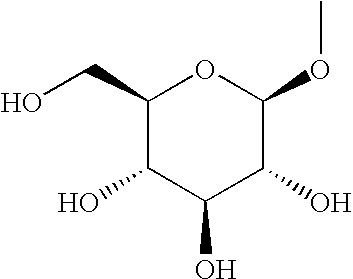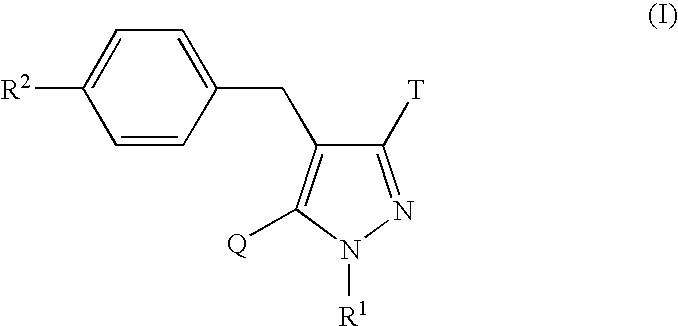Glucopyranosyloxypyrazole derivatives and medicinal use thereof
a technology of glucopyranosyloxypyrazole and derivatives, which is applied in the field of glucopyranosyloxypyrazole derivatives, can solve the problems of affecting the control and continuous performance sometimes adverse effects of biguanides and sulfonylureas, so as to improve the disturbance of insulin signal transduction, improve the effect of glucose uptake, and the effect o
- Summary
- Abstract
- Description
- Claims
- Application Information
AI Technical Summary
Benefits of technology
Problems solved by technology
Method used
Image
Examples
reference example 2
4-(Cyclopropylidenemethyl)benzyl alcohol
[0098]To a suspension of lithium aluminum hydride (0.16 g) in tetrahydrofuran (30 mL) was added methyl 4-(cyclopropylidenemethyl)benzoate (0.80 g), and the mixture was stirred at room temperature for 5 hours. Water (0.4 mL) was added to the reaction mixture, and the mixture was stirred for 3 days. Insoluble materials were removed by filtration, and the solvent of the filtrate was removed under reduced pressure to give 4-(cyclopropylidenemethyl)benzyl alcohol (0.69 g).
[0099]1H-NMR (CDCl3) δ ppm: 1.15–1.25 (2H, m), 1.35–1.50 (2H, m), 1.61 (1H, t, J=6.0Hz), 4.68 (2H, d, J=6.0 Hz), 6.70–6.80 (1H, m), 7.30–7.35 (2H, m), 7.50–7.55 (2H, m)
example 1
5-Methyl-4-{[4-(cyclopropylidenemethyl)phenyl]methyl}-1,2-dihydro-3H-pyrazol-3-one
[0100]To a solution of 4-(cyclopropylidenemethyl)benzyl alcohol (0.21 g) and triethylamine (0.18 mL) in tetrahydrofuran was added methanesulfonyl chloride (0.10 mL), and the mixture was stirred at room temperature for 30 minutes. Insoluble materials were removed by filtration. A solution of the obtained 4-(cyclopropylidenemethyl)benzyl methanesulfonate in tetrahydrofuran was added to a suspension of sodium hydride (60%, 0.052 g) and methyl acetoacetate (0.14 mL) in 1,2-dimethoxyethane, and the mixture was stirred at 70° C. for 5 hours. To the reaction mixture was added a saturated aqueous sodium hydrogen carbonate solution, and the mixture was extracted with diethyl ether. The organic layer was dried over anhydrous magnesium sulfate, and the solvent was removed under reduced pressure. To a solution of the residue in toluene was added anhydrous hydrazine (0.12 mL), and the mixture was stirred at 95° C. ...
example 2
5-Methyl-4-{[4-(cyclopropylidenemethyl)phenyl]methyl}-3-(2,3,4,6-tetra-O-acetyl-β-D-glucopyranosyloxy)-1H-pyrazole
[0102]To a suspension of 5-methyl-4-{[4-(cyclopropylidenemethyl)phenyl]methyl}-1,2-dihydro-3H-pyrazol-3-one (0.026 g) and acetobromo-α-D-glucose (0.049 g) in tetrahydrofuran was added silver carbonate (0.036 g), and the mixture was stirred at 60° C. overnight under light shielding. The reaction mixture was purified by column chromatography on aminopropyl silica gel (eluent: tetrahydrofuran) and successively by column chromatography on silica gel (eluent: hexane / ethyl acetate=1 / 3) to give 5-methyl-4-{[4-(cyclopropylidenemethyl)phenyl]methyl}-3-(2,3,4,6-tetra-O-acetyl-β-D-glucopyranosyloxy)-1H-pyrazole (0.010 g).
[0103]1H-NMR (CDCl3) δ ppm: 1.10–1.20 (2H, m), 1.30–1.45 (2H, m), 1.86 (3H, s), 2.03 (3H, s), 2.06 (3H, s), 2.11 (3H, s), 3.50–3.70 (2H, m), 3.80–3.90 (1H, m), 4.13 (1H, dd, J=2.3, 12.4 Hz), 4.31 (1H, dd, J=4.1, 12.4 Hz), 5.15–5.35 (3H, m), 5.50–5.65 (1H, m), 6.65–...
PUM
| Property | Measurement | Unit |
|---|---|---|
| temperature | aaaaa | aaaaa |
| temperature | aaaaa | aaaaa |
| reflux temperature | aaaaa | aaaaa |
Abstract
Description
Claims
Application Information
 Login to View More
Login to View More - R&D
- Intellectual Property
- Life Sciences
- Materials
- Tech Scout
- Unparalleled Data Quality
- Higher Quality Content
- 60% Fewer Hallucinations
Browse by: Latest US Patents, China's latest patents, Technical Efficacy Thesaurus, Application Domain, Technology Topic, Popular Technical Reports.
© 2025 PatSnap. All rights reserved.Legal|Privacy policy|Modern Slavery Act Transparency Statement|Sitemap|About US| Contact US: help@patsnap.com



